Delphi Archaeological Museum
The Museum of Delphi is considered among the three most important museums in Greece, together with the ones of the Acropolis of Athens and in Heraklion, Crete. What makes a visit to the Greek Museums in general, this one in particular, an unforgettable experience, is the fact that they usually exist on the very archaeological site(s), thus putting the exhibits in the surroundings in which they were initially established, in close relevance to their cultural and/or religious role.
The Delphi Museum first opened its doors tο the public in 1903; in the more than 100 years that have elapsed since then, it has been recognized as one of the most important museums in Greece. It has undergone many renovations during this time and four different exhibitions, each reflecting the scientific concepts and artistic standards as they evolved through the 20th century. The quality of the exhibits, though, has always been the main advantage of this Museum.
According to Rosina Colonia, (Delphi Ephorate of Antiquities) “… the Delphi exhibits speak for themselves: they have the power to command respect and captivate the visitor, inviting him or her to admire them, and leaving this visitor with the memory of their charm and the enigma surrounding them. Even though the exhibits on display today constitute no more than a small but representative part of the dedications seen by Pausanias at Delphi, and an even smaller part of the many more that inundated the sanctuary during the years of its heyday, they indisputably continue to delight people with their wealth, variety and beauty. …Delphi has been included in archaeology textbooks, it has adorned art books; some of the Delphi finds, such as the Treasury of the Siphnians, are landmarks in the history of ancient Hellenic art, while others, even though more than one hundred years have elapsed since they came to light, continue to be a focal point of scholarly discussions even today, owing to unanswered questions regarding their identity and interpretation. But above all, they still chaim the broad public who flock, like ancient pilgrims, to admire the monuments of Delphi”. (Quotation ©: John S. Latsis Public Benefit Foundation)
Photos will be gradually added in the near future
Select Page of the Album:
Click on any of the pictures to enlarge.
The Golden Age of Delphi: The First Monumental Votive Offerings. The Twins of Argos (Hall III)The two identical, over life-size statues, are the oldest (6th centu0ry BC.) monumental votive offerings at Delphi and one of the earliest examples of large-scale archaic sculpture. Such a pair of sculptures in ancient Greek art is quite rare. From the time of their discovery, they have been identified with two mighty and pious brothers from Argos, Cleobis and Biton, whom the Argives wished to honor by making and dedicating statues of them at Delphi. Other interpretations however identify the two statues as the Dioscuri, whose cult was widespread in the Peloponnese. Whether deities or heroised mortals, the two kouroi (sing. kouros, statue of a young standing male) by the Argive sculptor [Poly]medes provide us with a characteristic example of Argive sculptural work in the early 6th century BC, that is, at the time of transition from Daedalic to early Archaic art. Herodotos tells us their story in the following text:
“... (Cleobis and Viton were men of Arrive stock, had sufficient wealth as well as physical strength. They had both won prizes at athletic games and the following story is told of them: a festival of Hera was being celebrated in Argos and it was absolutely necessary for their mother to be taken by wagon to the temple dedicated to the goddess, but the oxen that were to drag it had not come back from the fields. As time passed, the two youths became anxious, so they harnessed themselves beneath the yoke and dragged the wagon, their mother riding on it, for a distance of 45 stades (approx. 8370 m- 9150 yards) until they reached the temple... And the mother, in her great joy at what they had done for her and the praise she had heard, stood in front of the statue of the goddess and prayed for Hera to give her sons, Cleobis and Viton, who had honored her so greatly, whatsoever is best for a man to receive. And after this prayer, when they had sacrificed and feasted, the two youths lay down to sleep in the sanctuary and never rose again. And the Argjves made statues in their likeness and dedicated them as offerings at Delphi, believing that they had proven themselves to be the best of men.” (Herodotus I. 31)
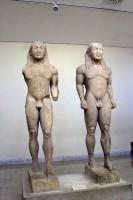
The Twins of Argos |
|
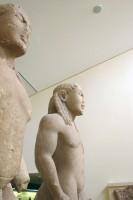
The Twins of Argos |
|
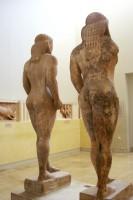
The Twins of Argos |
|
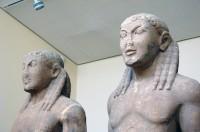
The Twins of Argos |
|
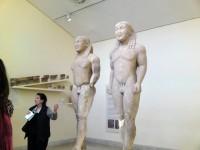
The Twins of Argos
credit: Smaro Mendrinou |
|
|
Select Page of the Album:
|
|



